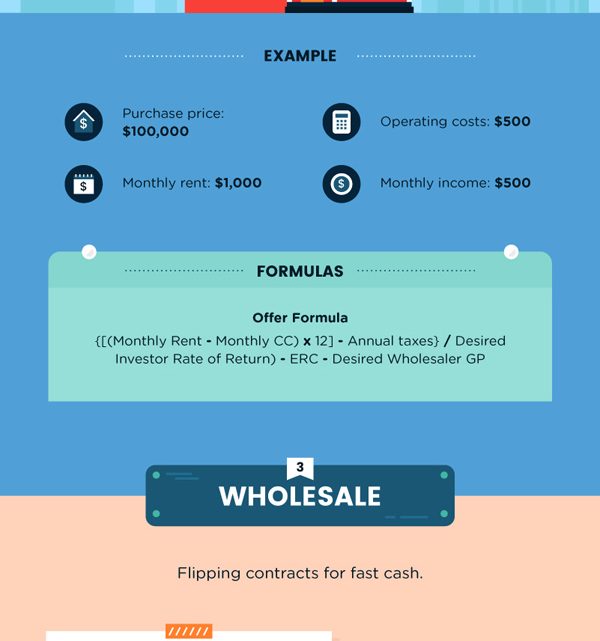The Best Real Estate Investment Strategies
 Seasoned investing veterans will tell you that the US real estate market is still one of the best investment avenues you can go into. However, most people who are just getting into investing are still reluctant because of real estate’s undeserved bad reputation, brought by the housing bubble and subprime mortgage crisis a few years back.
Seasoned investing veterans will tell you that the US real estate market is still one of the best investment avenues you can go into. However, most people who are just getting into investing are still reluctant because of real estate’s undeserved bad reputation, brought by the housing bubble and subprime mortgage crisis a few years back.
Warren Buffet once said that “Risk comes from not knowing what you’re doing.”, and another quote from him goes “be fearful when others are greedy, and greedy when others are fearful.” There is no doubt that in the previous real estate bubble, there were a few who got out richer while others were scrambling to cut losses, simply because they knew what they were doing.
Markets periodically go through “busts” or crash because prices can’t go on rising rapidly forever. However, compared to, say the stock market, the real estate market’s boom-and-bust cycle will go on for much longer, and that this may be the reason why some investors are usually caught unaware when things go awry.
They get lulled into complacency, thinking that the market would keep on growing at the same pace for years to come, and at the same time they get so caught up in the hype that they fail to see, and sometime deliberately ignore, the indicators of an impending bust.
This is why you should not be afraid of getting into real estate today, even if you are an inexperienced investor. The Chinese have a proverb that goes “The best time to plant a tree was 20 years ago the second best time is now”, which shows how critical a factor time is in investing. However, you do have to proceed armed with as much knowledge as possible, and not just follow what the latest strategy everyone is doing.
Now if you’re someone who’s already decided to get into real estate investing, but don’t know where to begin, then you’re probably looking for something actionable to get the ball rolling. You also need something that’s easy-to-understand. Baby steps is the way to go, take only small, well-calculated risks at first and never, ever blow your capital with a “get rich quick” goal in mind.
So it goes without saying that before you begin, you should have already done your homework diligently. If you did, then you should already have the following basic resources that you’ll be needing for almost all of the strategies that you’ll be trying out: motivated seller/internet leads, access to MLS (multiple listing service), a title company, a contractor, an LLC or business entity, and of course, funding.
Real Estate Investment Strategies Explained
Now it’s time to talk strategy. Most strategies that you’ll come across will fall under, or just be a variation of the following:
- Buy & Hold – this is where you purchase property mainly for the purpose of renting it out. Buying single-family homes for Airbnb or long-term rental, or commercial buildings for business are forms of buy-and-hold. This usually requires a sizeable initial investment, but there is also a way to fund this strategy using refinancing.
- Flips – this is a good way to make quick money by fixing up a property, usually residential ones that only require cosmetic improvements, and then reselling it.
- REITs and Lending – in the most basic sense, this is a kind of passive investment in the real estate market where a number of investors put their money in a fund so that the amount becomes big enough to purchase properties. Another way would be to lend your money to someone who is having difficulty getting a loan from the bank.
- Wholesaling – this is similar to flipping, but basically only involves finding a buyer for a seller and taking a percentage off the sale.
To narrow this down further, Houston real estate veterans OfferClimb has recently published an info-graphic revealing their top 4 strategies that new investors can use as reference. Straightforward as following a recipe in a cookbook, it breaks down the details of the process, the resources needed, the prerequisites, and the computation/formula on their version of the strategy in the simplest way possible.
The Lipstick Flip – here they recommend looking for properties that will only need minor cosmetic repairs. For example, if you purchase a property for $70k and fix it up at around $5k, the resale value should go up to around $100k, leaving you with a gross profit of $17k after closing costs of $8k.
Buy & Hold – as previously mentioned, you’d want to use this strategy if you’re looking for monthly cash flow. For example, if you get to buy a property at around $100k, you may want to put the monthly rent at around $1k. Putting the operation costs at $500 would leave you half in profit.
Wholesale – probably the quickest way to profit, this only involves you putting a contract assignment fee at around 10%. However, you do need to have an eye for under-priced properties, not to mention a good network or connections.
Buy, Renovate, Rent, Refinance, and Repeat – this is a long process where you need to recoup your capital using financing, but it is a replicable model that can get your short and long term gains. For example, if you buy a house at $100k and repair it for $5k, if you cash out from refinance in 6 months at $50k, you can get a $500 as an ongoing monthly rental income.
Be sure to check out the formula and other details by checking out the “4 Real Estate Investment Strategies For New Investors” info-graphic above.
About the author: Adam Winters is the co-founder of Sell My House Fast Houston Offer Climb and the Sell My House Fast Phoenix Offer Climb blog. Along with his co-founder Corey, they aim to provide home sellers with easy pay out schemes and quick sales.










No Comment